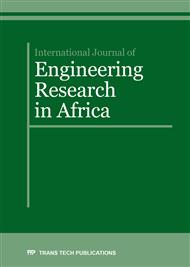[1]
Acharya, V.V. and L.H. Pedersen (2005), Asset pricing with liquidity risk, J. Financ. Econ., 77 (2), 375-41.
Google Scholar
[2]
Akotey, A.J. (2007), Interview with Armah Akotey, Vice President of Investment, Data Brokerage Ltd, Accra, Ghana. 23 December, (2008).
Google Scholar
[3]
Amihud, Y. (2002), illiquidity and stock returns: cross-section and time –series effects, Journal of Financial Markets, 5, 31-56.
DOI: 10.1016/s1386-4181(01)00024-6
Google Scholar
[4]
Banz, R.W., 1981, the relationship between returns and market value of common stock, Journal of Financial Economics, 9, 13-18.
Google Scholar
[5]
Bekaert, G., Harvey, C.R., Lundblad, C., 2007. Liquidity and expected returns: lessons from Emerging Markets. Rev. Financ. Stud. 20, 1783-1831.
DOI: 10.1093/rfs/hhm030
Google Scholar
[6]
Brennan, M.J., W. Huh and A. Subrahmanyam(2011), An analysis of the Amihud Illiquidity premium, Working paper, UCIA.
Google Scholar
[7]
Brennan M.J., and A. Subrahmanyam (1996), Market microstructure and asset pricing: on the compensation for illiquidity in stock returns,J. Financ. Econ, 41 (3), 441-464.
DOI: 10.1016/0304-405x(95)00870-k
Google Scholar
[8]
Chiang T.C. and D. Zheng(2010), An empirical analysis and herd behavior in the global stock markets,. Journal of Banking and Finance, 34, 1911-(1921).
DOI: 10.1016/j.jbankfin.2009.12.014
Google Scholar
[9]
Chordia, T., R. Roll and A. Subrahmanyam(2000), Commonality in liquidity,. Journal of Financial Economics, 56, 3-2.
DOI: 10.1016/s0304-405x(99)00057-4
Google Scholar
[10]
Databank (2004). Epack Investment Fund Limited Annual Report, Ghana.
Google Scholar
[11]
Datar, V.T., Y.N. Naik and R. Radcliffe (1998), Liquidity and stock returns: an alternative test ,J. Financ. Mark, 1 (2), 203-219.
DOI: 10.1016/s1386-4181(97)00004-9
Google Scholar
[12]
Fabre, J., and A. Frino (2004).
Google Scholar
[13]
Hearn Bruce (2011).
Google Scholar
[14]
A., Lee, K.H., van Dijk,M., 2012. understanding commonality in liquidity around the world.J. Financ. Econ. 105, 82-112.
Google Scholar
[15]
KPMG (2008) International survey of corporate responsibility reporting. http: /www. kpmg. eu/docs/Corp_responsibility_Survey_2008. pdf Kyle, A.S. (1985), Continuous auctions and insider trading, Econometrica, 5 3(6), 1315-1335.
DOI: 10.2307/1913210
Google Scholar
[16]
Lee, K.H. (2011), The World price of liquidity risk', J. Financ. Econ., 99(1), 136-161. Lesmond D.A., J.P. Orden and C.A. Trzcinka (1999), 'A new estimate of transaction costs, Rev. Financ. Stud., 12(5), 1113-1141.
DOI: 10.1093/rfs/12.5.1113
Google Scholar
[17]
Limkriangkrai,M., R.B. Duran and I. Watson(2008), Is liquidity the missing link? , Account. Financ., 48, 829-845.
Google Scholar
[18]
Liu,W. (2006), A liquidity-augmented capital asset pricing model,.J. Financ. Econ., 82 (3), 631-671.
DOI: 10.1016/j.jfineco.2005.10.001
Google Scholar
[19]
Mosley, P. Subusat; and Weeks ,J., (1995)Assessing "adjustment in Africa World Development 23(9), 1473.
Google Scholar
[20]
Pastor, l., and R.F. Stambaugh (2003), liquidity risk and expected stock returns, Journal of Political Economy, 111, 642-685.
DOI: 10.1086/374184
Google Scholar
[21]
Paul CM, Siegel D (2006) Corporate social responsibility and economic performance. J Prod Anal 3: 207–211.
Google Scholar
[22]
Sally, Farid(2013)Financial integration in African Emerging Markets.
Google Scholar
[23]
Wheeler, D(1984)sources of slow growth in Africa. World Development, 12, 1.
Google Scholar


